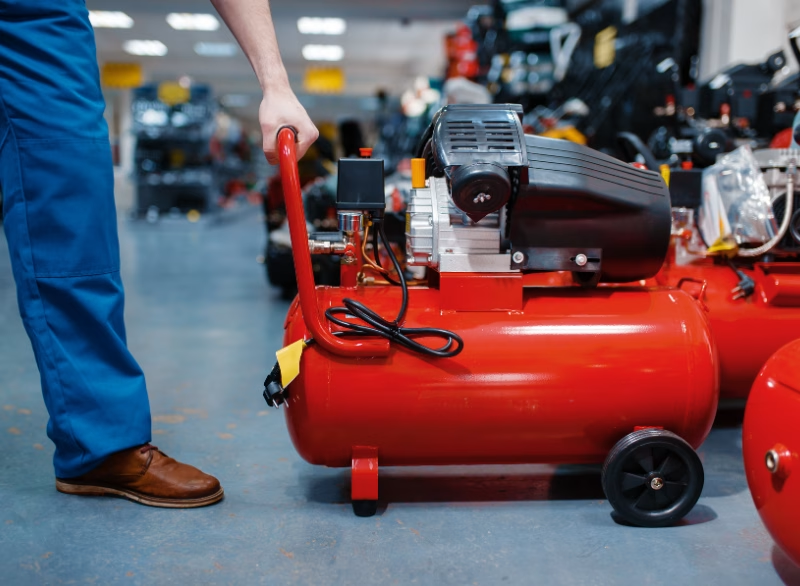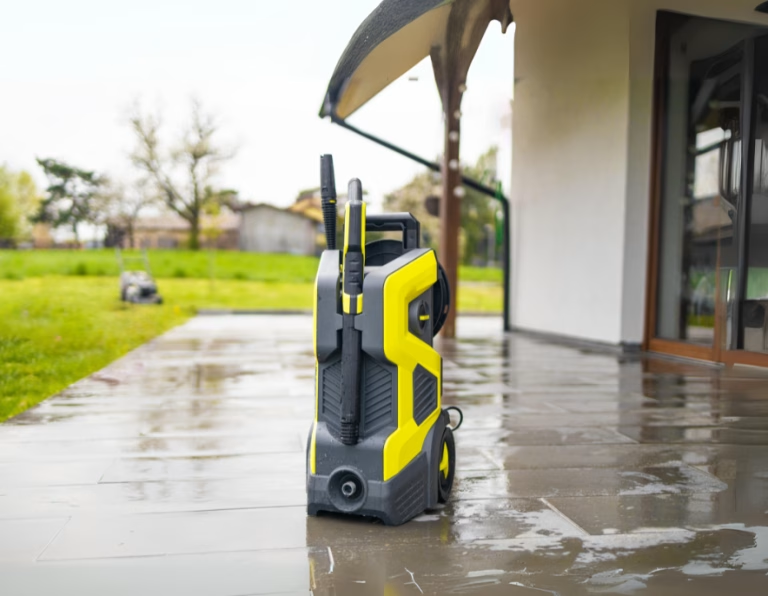Air compressors are essential tools for powering a wide range of equipment. In 2025, choosing the right air compressor means better efficiency and performance. This guide covers the basics, types, and key features to help you find the perfect compressor for your needs.
1_What Is Air Compressor ?
It is a device that converts power into potential energy stored in pressurized air. The basic mechanism involves an electric motor or gas engine driving a pump, which compresses air and stores it in a tank. The stored air can then be released through hoses to power various tools and devices

2_The Types Of Air Compressors
There are different types of air compressors, each with unique operating methods. The most common types are piston compressors and rotary screw compressors.
2.1_Piston Air Compressors
Also known as a reciprocating air compressor, is the oldest and most common of all industrial compressors, it is available as single-stage or dual-stage, oil-lubricated or oil-free versions, with a different number of cylinders in different configurations. [1] You can usually find a piston compressor in work, machine shops, and tire shops, as well as light manufacturing facilities.
They can only work at about 50-60% of their duty cycle. This reduced runtime means piston compressors run 30-35 minutes every hour, with required downtime. These units need proper cooling time between cycles, otherwise they will overheat or break.
In addition is important to understand that piston compressors create a lot of downstream oil. If not treated properly, they can damage machines utilizing compressed air.
2.1.1_How Does A Piston Air Compressor Work?
A piston air compressor is a type of compressor that uses pistons driven by a crankshaft to compress air. Specifically, these compressors operate on the principle of reciprocating motion, in which the piston moves back and forth within a cylinder to draw in and compress air. As a result, they are well-suited for applications that require intermittent air supply and relatively lower duty cycles.
2.1.2_Advantages Of Piston Air Compressor:
Simple and robust, least expensive, ease of maintenance, long lifespan.
2.1.3_Disadvantages Of Piston Air Compressor:
very loud when operating, meant for intermittent use, regular oil changes and maintenance of components like valves and pistons
2.2_Rotary Screw Compressors
If your application(s) require a constant compressed air supply, then you should consider a rotary screw air compressor. Compared to piston compressors, these machines are capable of handling a 100% continuous duty cycle. Furthermore, they are designed and built for reliable, all-day operation. In addition, rotary screw compressors typically feature advanced control systems that regulate the compressor’s operation, thus ensuring optimal performance and energy efficiency.y.
Rotary screw compressors come with more options than piston machines. For instance, most of them are built with an integrated dryer for clean, dry air. Furthermore, smaller screw compressors can be tank-mounted, which allows for additional storage capacity while saving on space and installation costs. Additionally, when coupled with an integrated dryer, the installation becomes plug and play.[2]
2.2.1_Working Principle Of A Screw Compressor
A rotary screw air compressor operates using a positive displacement mechanism that employs twin spiral screws, also known as rotors. First, these rotors are precisely aligned and rotate in opposite directions. As a result, air is trapped between them and the compressor housing. Then, this trapped air is progressively compressed as it moves along the rotors. Ultimately, this process results in a steady flow of pressurized air.
2.2.2_Advantages Of Screw Compressors
Low Noise Levels, Continuous Operation.
2.2.3_Disadvantages Of Screw Compressors
Higher Initial Cost, Complexity.
3_What Size Air Compressor Should I Get?
To begin with, the appropriate size of a compressor depends on the task it is intended to perform. Therefore, it is crucial to first determine the pressure and flow required for the task, as well as the necessary force and its duration. Once you have this information, you’ll be better equipped to make the right decision.
When researching air compressor types, it’s worth considering the following points:
● Application / industry requirements
● Air flow utilization
● Pressure needs
● Usage time throughout the day
● Future expansion plans
4_Air Compressor Oil: What It Is? and Which to Use?
Like cars, air compressors also need the right amount of oil for proper lubrication. In fact, air compressor oil is used to grease mechanical parts, preventing damage from overuse and improving air compression efficiency. Furthermore, there are two main common types of air compressor oil: mineral oil and synthetic oil. These lubricants, however, differ in viscosity and additives.
Mineral oil is produced from petroleum refining.
Syntheticic oil is created in laboratories. In general, it lets the compressors work in a more silent way and it can be used with a wider range of temperatures than the mineral oil since it protects the machine from overheating.
The choice of oil for air compressors depends on the type of compressors you use, their life cycle and how you use them.
Both mineral and synthetic oil are suitable for air compressors. Typically, mineral-based oil is ideal for small- to medium-sized compressors that operate occasionally. For this reason, it is commonly chosen for compressors used at home. On the other hand, if your compressor is used for professional or industrial applications, synthetic oil is the better choice, as it offers greater protection against overheating. However, it’s highly recommended to check your compressor’s handbook before using any type of oil to ensure compatibility and performance.
5_Best Air Compressor Recommendations to Suit Your Specific Needs
After reviewing top consumer reports, expert reviews, and checking with leading retailers, we have identified these trusted brands for air compressors. These brand offer reliable performance and high-quality features to meet your cleaning needs effectively.
1. California Air Tools
The California Air Tools 10020C Air Compressor (larger jobs) | California Air Tools 8010 Air Compressor (lighter tasks).
1.1_California Air Tools 10020C
- Tank Capacity: 10 gallons
- Noise Level: 70 decibels (ultra quiet)
- Airflow: 6.40 CFM at 40 PSI / 5.30 CFM at 90 PSI
- Maximum Pressure: 125 PSI
- Motor Power: 2.0 HP (peak) / 1.5 HP (running), uses piston mechanism
- Oil-Free Pump: Yes (less maintenance, cleaner operation)
- Weight: 82.5 lbs
- Other Features: Larger tank, longer run time for tools, wheels for portability.
- Price Range: falls between $379 and $459
1.2_California Air Tools 8010
- Oil-Free Pump: Yes (low maintenance)
- Tank Capacity: 8 gallons
- Noise Level: 60 decibels (ultra quiet)
- Airflow: 3.10 CFM at 40 PSI / 2.20 CFM at 90 PSI
- Maximum Pressure: 120 PSI
- Motor Power: 1.0 HP (running), uses piston mechanism
- Weight: 54 lbs
- Other Features: Lighter, more portable, quieter.
- Price Range: Falls between $180 and $230
2_ Bostitch BTFP02012 Pancake Air Compressor (used for light to medium-duty tasks)
- Motor Power: 0.8 HP (running), uses piston mechanism
- Tank Capacity: 6 gallons
- Noise Level: 78-80 decibels
- Airflow: 2.6 CFM at 90 PSI
- Maximum Pressure: 150 PSI
- Oil-Free Pump: Yes (low maintenance)
- Weight: 29 lbs
- Price Range: Typically between $174 to $274.
3_ Makita
3.1_Makita MAC2400 Big Bore ( heavy-duty tasks)
- Maximum Pressure: 130 PSI
Tank Capacity: 4.2 gallons
Noise Level: 79 decibels
Airflow: 4.2 CFM at 90 PSI
Motor Power: 2.5 HP (running), uses piston mechanism
Oil-Free Pump: No (requires maintenance with oil lubrication).
Weight: 77 lbs
Price Range: Typically between $350 to $450
3.2_Makita MAC210Q Quiet (for quieter tasks)
- Airflow: 2 CFM at 90 PSI
- Tank Capacity: 2.1 gallons
- Noise Level: 60 decibels
- Maximum Pressure: 135 PSI
- Motor Power: 1 HP (running), uses piston mechanism
- Oil-Free Pump: Yes (requires no maintenance)
- Weight: 44 lbs
- Price Range: Typically between $300 to $320
4_Dewalt
4.1_Dewalt D55140 (Portable easy to carry for light tasks)
- Noise Level: 71.5 decibels
- Tank Capacity: 1 gallons
- Airflow: 0;75 SCFM (standard cube feet per meter) at 90 PSI
- Maximum Pressure: 135 PSI
- Motor Power: 0.33 HP
- Oil-Free Pump: Yes (requires no maintenance)
- Weight: 24 lbs
- Price Range: Typically between $180 to $220
4.2_DEWALT DWFP55126 Pancake (hand carry for light tasks)
- Tank Capacity: 6 gallons
- Noise Level: 75.5 decibels
- Airflow: 2.6 SCFM at 90 PSI
- Maximum Pressure: 165 PSI
- Motor Power: 0.9 HP
- Oil-Free Pump: Yes (requires no maintenance)
- Weight: 30 lbs
- Price Range: Typically between $200 to $260
5_ Metabo
5.1_Metabo HPT EC28M (Good for DIY Projects)
- Tank Capacity: 1 gallon
- Noise Level: 59 decibels
- Airflow: 1.3 CFM at 40 PSI & 0.8 CFM at 90 PSI
- Maximum Pressure: 125 PSI
- Motor Power: 0.5 HP
- Oil-Free Pump: Yes (requires no maintenance), uses piston mechanism
- Weight: 25.2 lbs
- Price Range: Typically between $175 to $200
6_Maintenance Tips to Extend Your Air Compressor's Lifespan
Ensuring your air compressor operates efficiently and lasts as long as possible involves regular maintenance and the right tools. Furthermore, incorporating routine checks and proper upkeep not only extends the lifespan of your equipment but also enhances its overall performance Here are some key tips to help you extend the lifespan of your air compressor:
- Changing your compressor’s oil (typically needed every six months): Oil lubricates the moving parts inside the compressor, reducing friction and wear. However Over time, oil can degrade and become contaminated, leading to reduced efficiency and potential damage.
- Checking air & oil filters, vents, belts and bearings for dirt and grime buildup: Periodically check your air compressor’s air and oil filters, vents, belts, and bearings for dirt and grime buildup. Regular cleaning of these components helps maintain efficient operation, prevents overheating, and extends the lifespan of your equipment.
- Reapplying lubricant to all applicable parts of compressor: Regularly reapply lubricant to all applicable parts of your air compressor. Proper lubrication reduces friction, prevents wear, and ensures smooth operation, ultimately extending the lifespan of your equipment.
- Checks for Leaks: Identifying and repairing leaks helps maintain efficiency, prevent energy loss, and avoid potential damage to the system, ensuring optimal performance.





